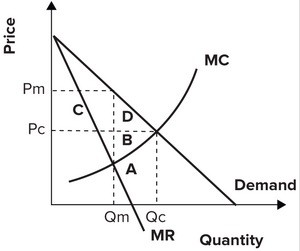Even though explicit contracts may lead to layoffs during recessions, explicit contracts may still be efficient because such contracts
A. guarantee that only the least-productive workers will be laid off.
B. reduce negotiation costs.
C. reduce unemployment effects.
D. will equitably spread the layoffs among junior and senior workers.
Answer: B
You might also like to view...
The relationship that tells us how much a person intends to spend at various levels of income is
A) the expenditure function. B) the consumption function. C) the buying function. D) the spending function.
Municipalities that have adopted the policy of "rent control" typically set the rentals on certain apartments well below equilibrium. As a result,
A) landlords have a difficult time finding tenants. B) prospective tenants have a difficult time finding available apartments. C) there is a surplus of apartments. D) All of the above.
Refer to the graph shown. Areas C and D represent:
A. the loss of surplus by producers resulting from a monopoly. B. consumer surplus redistributed to the monopolist. C. the cost to society of increasing output from Qm to Qc. D. the loss of surplus by consumers resulting from a monopoly.
The difference between a three-digit North American Industry Classification System (NAICS) industry and a six-digit NAICS industry is that:
A. the three-digit industry is more specifically defined than the six-digit code. B. three-digit codes apply to a different set of industries than six-digit codes. C. three-digit codes are used to classify industries whereas six-digit codes are used to classify firms. D. the six-digit industry is more specifically defined than the three-digit code.